方案详情文
智能文字提取功能测试中
N.S. Kozlova, E.V. Zabelina,I.S. Didenko, A.P. Kozlova,Zh.A. Goreeva, TNUST"MISiS", Russia Application Note AgilentGlass, Ceramics and Optics Trusted Answers Investigation of Dichroism by Spectrophotometric Methods Introduction Pleochroism (from ancient greek Tt入eov 《more》+xpóua 《color》) is an opticalphenomenon when a transparent crystal will have different colors if it is viewed fromdifferent angles (1). Sometimes the color change is limited to shade changes suchas from pale pink to dark pink (2). Crystals are divided into optically isotropic (cubic crystal system), opticallyanisotropic uniaxial (hexagonal, trigonal, tetragonal crystal systems) and opticallyanisotropic biaxial (orthorhombic, monoclinic, triclinic crystal systems). The greatest change is limited to three colors. It may be observed in biaxial crystalsand is called trichroic. A two color change may be observed in uniaxial crystals andcalled dichroic. Pleochroic is often the term used to cover both(2). Pleochroism is caused by optical anisotropy of the crystals(1-3). The absorption of light in the optically anisotropiccrystals depends on the frequency of the light wave and itspolarization (direction of the electric vector in it) (3, 4). Generally, any ray of light in the optical anisotropic crystal isdivided into two rays with perpendicular polarizations anddifferent velocities (v., V) which are inversely proportional tothe refractive indices (n,n,) (4). In uniaxial crystals there is a single direction governing theoptical anisotropy whereas all directions perpendicular toit (or at a given angle to it) are optically equivalent. Thus,rotating the material around this axis does not change itsoptical behavior. This special direction is known as the opticaxis of the material (5). This direction is parallel to the axis ofsymmetry of highest order: 6 for hexagonal, 3 for trigonal, 4for tetragonal (6). Light whose polarization is perpendicularto the optic axis is governed by a refractive index n (for"ordinary"). Light whose polarization is in the direction ofthe optic axis sees an optical index n (for "extraordinary").For any ray direction there is a linear polarization directionperpendicular to the optic axis, and this is called an ordinaryray. However, for ray directions not parallel to the optic axis,the polarization direction perpendicular to the ordinary ray'spolarization will be partly in the direction of the optic axis,andthis is called an extraordinary ray. The ordinary ray will alwaysexperience a refractive index of n, whereas the refractiveindex of the extraordinary ray will be in between n andn ,depending on the ray direction as described by the indexellipsoid. (5) So, if the light travels through the crystal along the optical axisthere would be no change of color or shade with the rotationof the sample around the direction of light. If light travels in the direction perpendicular to the opticalaxis then we may observe change of color or shade with therotation of the sample around the direction of light - this isdichroism. The main points of the dichroism are the following (2, 7, 8): - dichroism may be observed only in uniaxial crystals -(colored uniaxial crystals may not be dichroic (or dichroismmay be so small that it can't be observed by naked eyesbut can be detected by highly precise optical instruments) -(colorless in visual wavelength range crystals maydemonstrate dichroism in UV or IR wavelength ranges Dichroism is an evidence of the anisotropy of the absorbingcenters (7). Dichroism can be observed in non-polarized light but inpolarized light it may be more pronounced if the plane ofpolarization of incident light matches plane of polarization oflight that propagates in the crystal-ordinary or extraordinarywave. The difference in absorbance of ray lights may be minor, butit may be significant and should be considered both whenreporting optical properties and when using the crystal. Thisis why any uniaxial crystal should the examined for dichroism. Equipment To investigate dichroism we used an Agilent Cary 5000UV-Vis-NIR spectrophotometer equipped with a UniversalMeasurement Accessary (UMA). This system allows us to carry out experiments in wavelengthranges for -nnon-polarized light-190-2800 nm -ppolarized light-250-2500 nm. To carry out experiments using polarized light, the systemis equipped with an automatic polarizer controlled by thecomputer. The accuracy of the Cary 5000 instrument is high enoughto provide data on dichroism even in cases when dichroismis very small and the sample seems to be transparent andcolorless when viewed with the naked eye. Samples Samples should have 2 plane-parallel polished surfacesparallel to the optic axis. The best sample is the oriented sample-when you exactlyknow where crystallographic axes (axes related to theelements of symmetry) Xand Y are located. Method Investigation of dichroism phenomenon consists of obtainingtwo spectra in the same region of the sample: irin case of non-polarized light, the sample should berotated in the sample holder by 90 degrees around thelight ray; - iirn case of polarized light, two spectra are measured withpolarizer in the 0 degree and then the 90 degree position. The Cary 5000 allows the measurement of transmissionor absorption spectra. In addition, data obtained can berecalculated to any other demanded values. Dichroism is characterized by the degree of dichroism (9, 10): where D, is the optical density of the light transmitted throughthe sample in the sample position1 ; D,-in the position 2. or where p is the maximum spectral attenuation coefficientfor the experimental wavelength and p is the minimumspectral attenuation coefficient for that wavelength. Spectral attenuation coefficient p() with considerationof multiple reflection is determined by calculations frommeasurements of spectral transmission T(A) using materialrefractive index n: where d is the specimen thickness, cm; t,(A) is the spectralcoefficient of the internal transmission of the sample,arbitrary units. Internal transmittance T,(A): where T(A) is the spectral transmission measured on thespectrophotometer;n(入) is the refractive index of the material. Results Oriented cubes of CaMoo were measured with the Cary 5000UMS instrument. The planes of the cubes were perpendicularto the optical axis (Z or axis of symmetry of 4th order) and theaxis of 2nd order (X and Y).CaMoo belongs to the tetragonalsymmetry and is characterized by two refractive indices Noand Ne. The experiment was carried out along X, Y and Z axis. Dichroism by naked eye Dichroism in the samples of CaMoo single crystals can beobserved by naked eye, as shown in Figure 1. Figure 1. Image of a CaMoO, sample in two orientations; crystals x-axisparallel to optical axis (left) and (X+90°) crystals x-axis perpendicular to theoptical axis. The cubic sample was rotated by 90 degrees relative to theaxis of light passing along the direction perpendicular to theoptical axis of the crystal. In one position the sample is blue,and in other is grey-orange. The phenomenon is pronounced along axis of 2nd order (X, Y)and along axis of 4th order (Z) no change of color is observed. Dichroism by spectrophotometer We measured the optical transmission in the differentpositions of the sample in regard of incident light according tothe scheme (Figure 2). a) Figure. 2. The measurement scheme of CaMoosamples: a) measurementsalong the X-axis and (X+90°);b) along the Y-axis and (Y+90°);c) along theZ-axis and (Z+90°);(X+90°),(Y+90°),(Y+90°)-sample is rotated by 90°around the X, Y and Z axes respectively According to the formula (3) we calculated the attenuationcoefficients, according to formula (2)-the degree ofdichroism, and plotted their spectral dependences (left-handand right-hand scale in Figure 3 respectively): Figure 3. The spectral dependence of p(X)of CaMoO single crystal and thedegree of dichroism▲: Upper graph: Along X and Y axis, black and grey solid and dotes lines refer toleft axis: black- crystallography X axis, grey - crystallography Y axis, solid line-initial position, dotes - sample was turned at 90° around the incident lightray; dash point curve refers to right axis; Lower graph: Along the optical axis Z solid line - initial position, dotes - sample was turned at 90°around the incident light ray If you compare the 2 solid or 2 dotted lines you will see thatanisotropy of attenuation is insignificant: values in the X axiscoincide values in Y (Figure 3, upper). But if you compare2 black (measurements along X axis) or two grey lines(measurements along Y axis) you will see the differencebetween the attenuation in two positions -attenuationchanges with the rotation by 90° around the incident light ray.This difference achieves its maximum 0.3 cm1 at 450 nm(dot-dash curve, Figure 3, upper). This is dichroism on thespectral dependences. Also with the rotation of the sample, the maximum of theattenuation bands shift and this result in the change of color.Along Z-direction (parallel to the optical axis), there is nosignificant changes in the attenuation in two positions of thesample (Figure 3, lower). This phenomenon also may occur in any other birefringentmaterials. For example, dichroism in trigonal crystals isreported by Kozlova N. S., Buzanov O. A., Zabelina E. V.,Kozlova A. P., Bykova M. B. in "Point Defects and Dichroism inLangasite and Langatate Crystals" (Crystallography Reports.-2016.-Vol.61.-No.2.-p.275-284.) 6. http://reference.iucr.org/dictionary/Arithmetic_crystal_class. Accessed November 2018. 7. Herbert Smith F.S., Revised by Phillips, G.F., Gemstones,London, Chapman & Hall, 1972. 8. Maier A. A., Physical Chemistry of Solids: Crystal Optics(Izd-vo MKhTI, Moscow, 1984) [in Russian], pp 84.N. Conclusions The Cary 5000 UV-Vis-NIR spectrophotometer fitted witha Universal Measurement Accessory (UMA) provided therequired measurement flexibility, and S/P polarization controldetermine the degree of dichroism of birefringent materials. 9. Kozlova, O. Buzanov, A. Kozlova, E. Zabelina, V. Shayapov,Nikita Siminel, Radiation-induced defects and dichroismin La,GassTawsO14 crystals, Radiation & Applications, vol.1, issue 3, pp. 171 -176,2016 Measurements of %R and %T were made along crystal axes(X, Y, Z), with non-polarized light and polarized light (parallelto, and perpenticular to, the optical axis). Spectrophotometricmeasurements afforded by being able to automaticallyposition the UMA detector at any point in a 340° arc aroundthe sample. 10. Tudor T., Manea V., Symmetry between partially polarizedlight and partial polarizers in the vectorial Pauli algebraicformalism, J.Mod. Opt., vol. 58, no 10, pp. 845-852,2011. Dichroism should be taken into account in the investigation,and interpretation, of the optical properties of birefringentmaterials. The Cary 5000 with UMA has proven to be acapable and convenient tool for such analysis. 1. Bloss, F. Donald, An Introduction to the Methods of OpticalCrystallography, New York:Holt, Rinehart and Winston.pp. 147-149,1961 2. http://www.galleries.com/minerals/property/pleochro.htm. Accessed November2018. 3. Sears F.W.,Zemansky M.W., Young H.D., UniversityPhysics 6th ed,Pearson, 4 Sivukhin D. V.General course of physics. 3rd edition,stereotyped. M.: Fizmatlit, Moscow, 2002. Vol. IV. Optics.[in Russian] 792 p. 5. https://science-train.com/w/Birefringence/Explanation.html Accessed November 2018 www.agilent.com/chem 多色性是一种透明晶体从不同角度观察会产生不同颜色的光学现象。有时颜色的变化仅限于阴影的变化,如从浅粉色变成深粉色。晶体可分为光学各向异性(立方晶体体系)、光学各向异性单轴(六角、三角晶体体系)和光学各项异性双轴(斜方、单斜、三斜晶体体系)几类。最大的变化仅限于三种颜色变化,这种现象一般可在双轴晶体中观察到,成为三色晶体。在单轴晶体中可以观察到双色变化,称为二色性。多色性经常被用来形容以上两种现象。多色性是由晶体的光学各向异性引起的。在光学各向异性晶体中,光的吸收取决于光波的频率和它的偏振。为研究晶体的二色性,可使用安捷伦的Cary5000 UV-Vis-NIR分光光度计搭配全能测量附件(UMA)进行测试。UMA系统标配软件自动控制的偏振器,可自动发射出测试需要的P光和S光,满足实验测量的需求。
关闭-
1/5
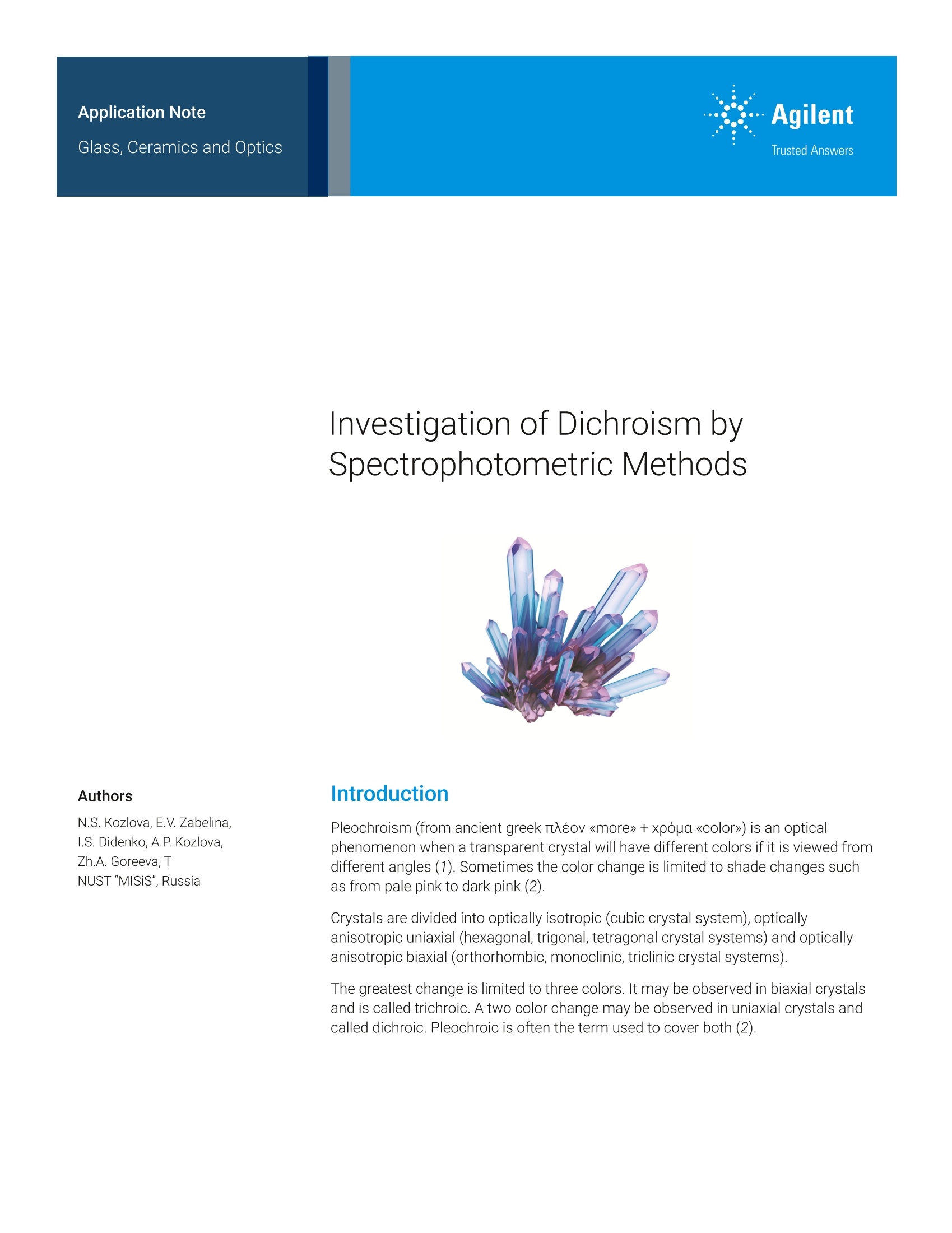
-
2/5
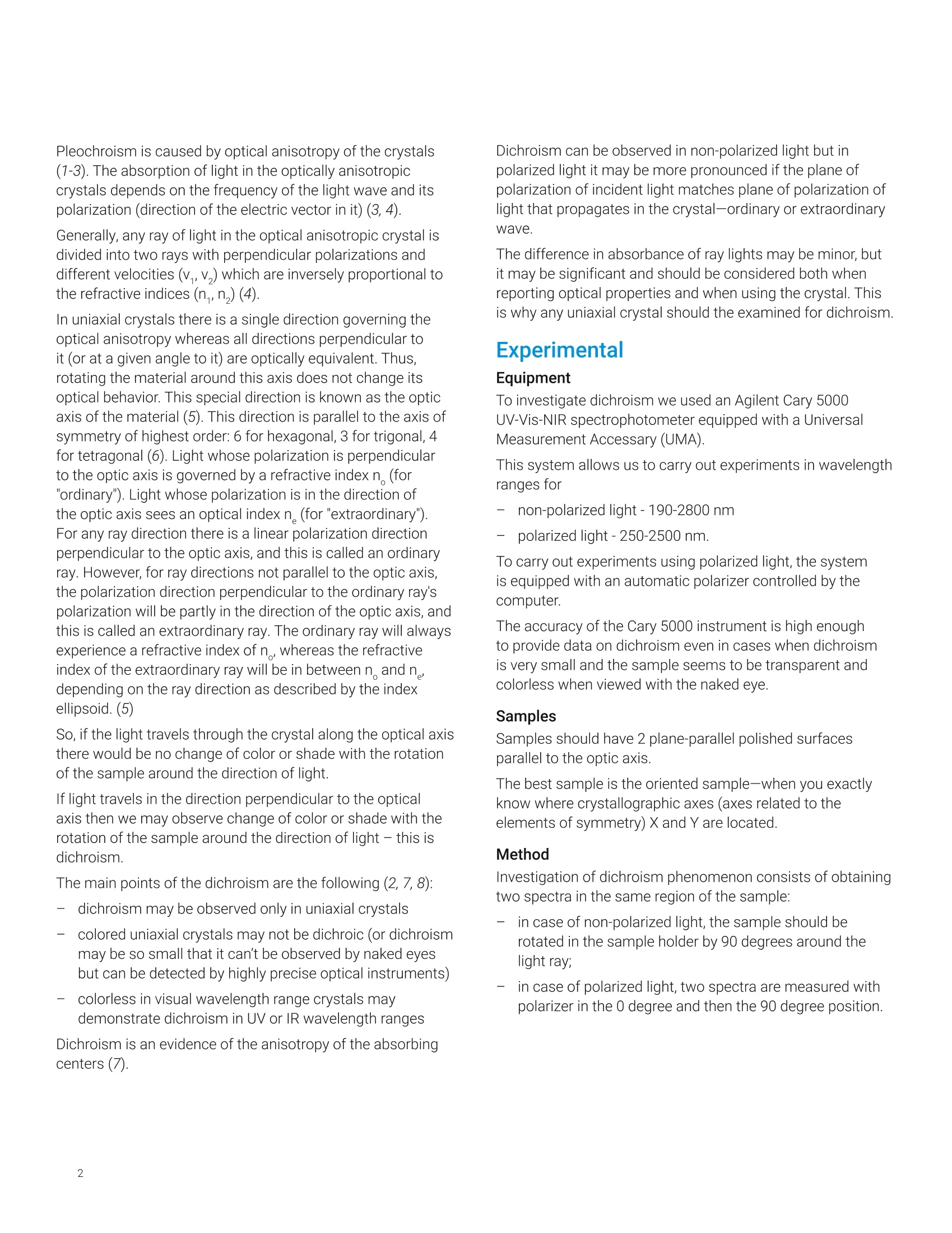
还剩3页未读,是否继续阅读?
继续免费阅读全文产品配置单
安捷伦科技(中国)有限公司为您提供《晶体材料中二色性检测方案(紫外分光光度)》,该方案主要用于其他中二色性检测,参考标准《暂无》,《晶体材料中二色性检测方案(紫外分光光度)》用到的仪器有Cary 5000 紫外可见近红外分光光度计、Agilent Cary 7000 全能型分光光度计(UMS)。
我要纠错
推荐专场
紫外、紫外分光光度计、紫外可见分光光度计、UV
更多相关方案


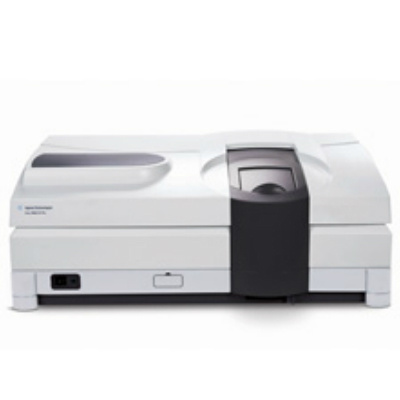
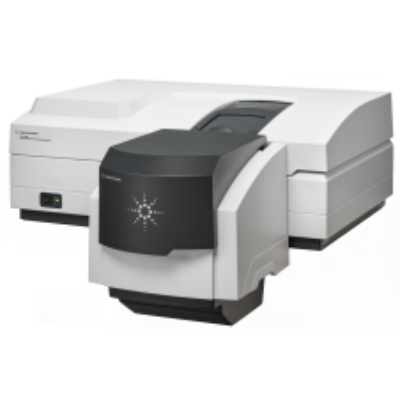
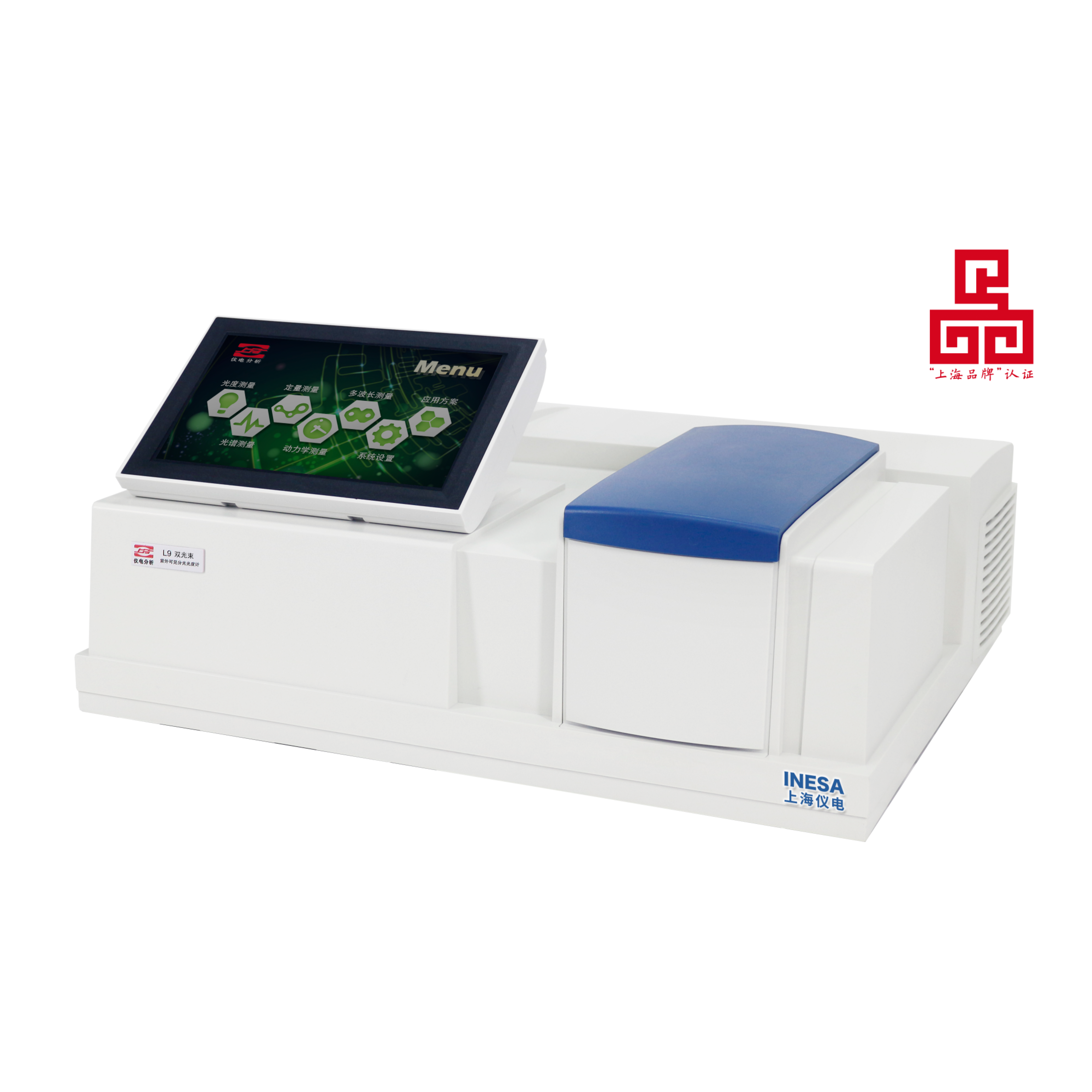
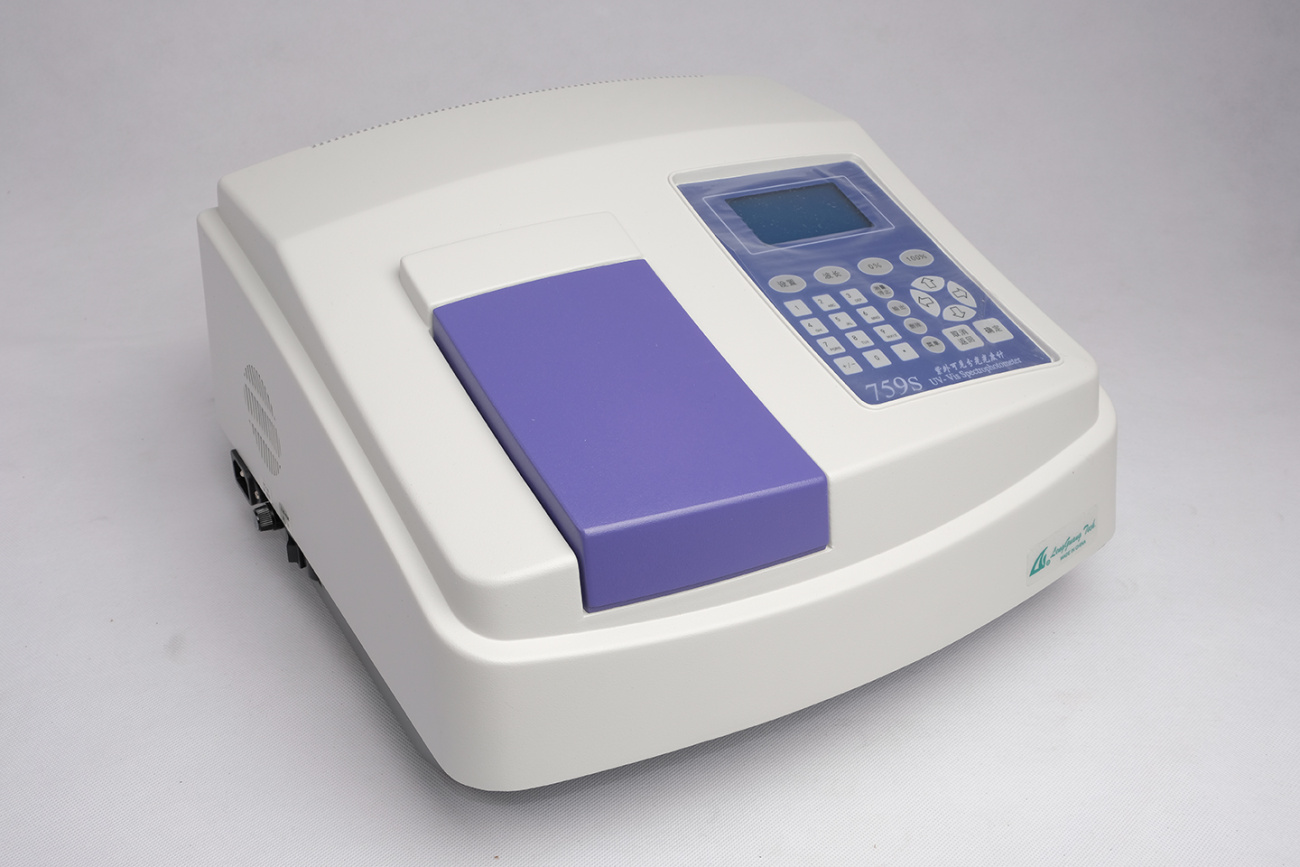
 咨询
咨询